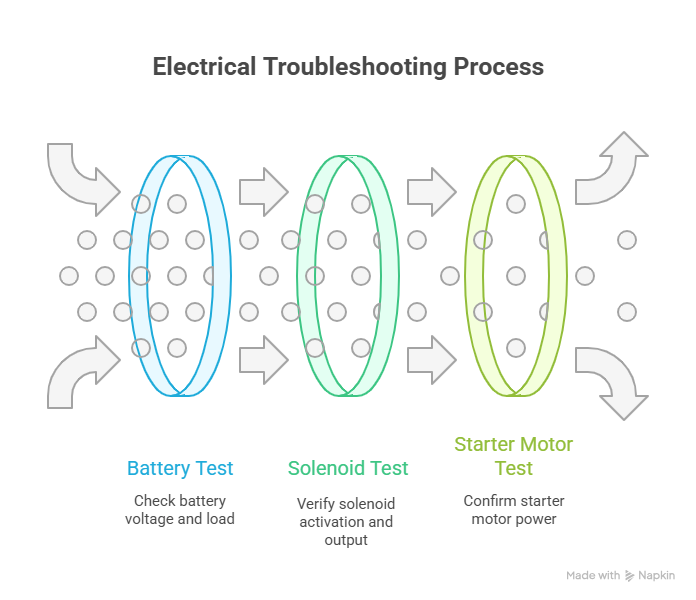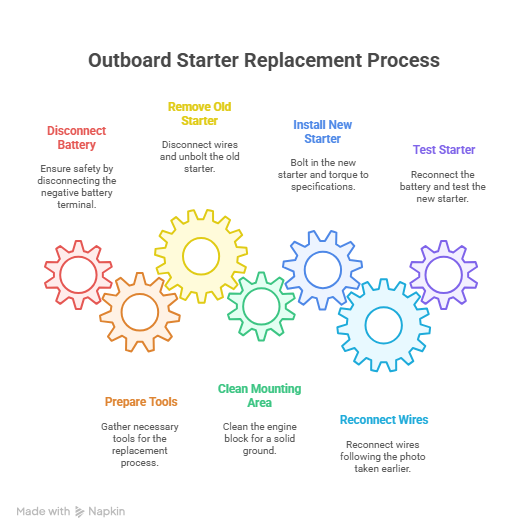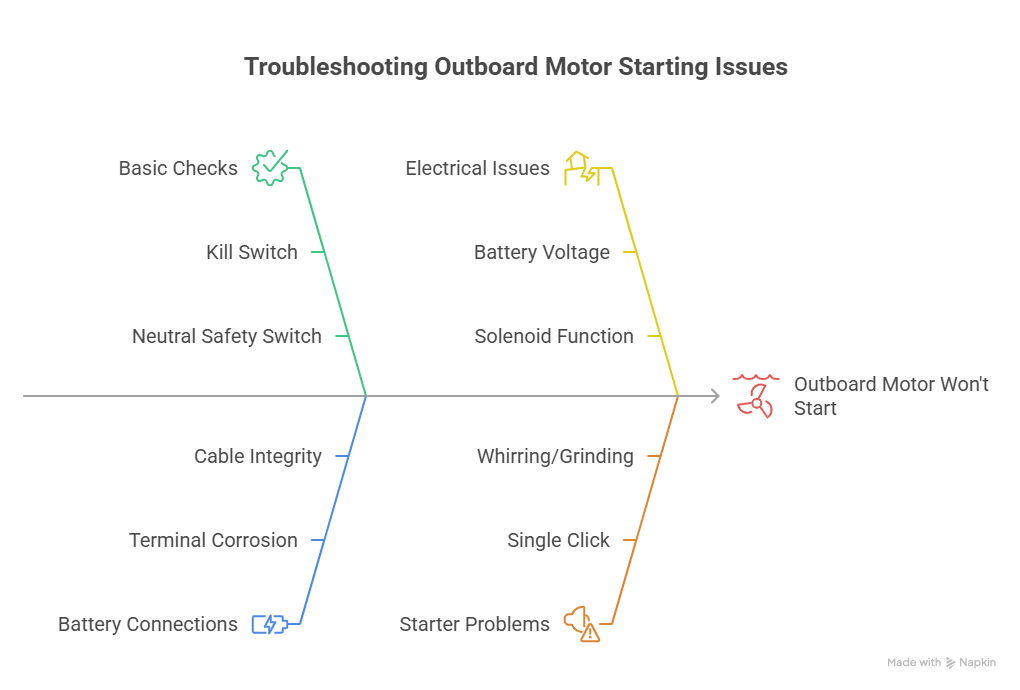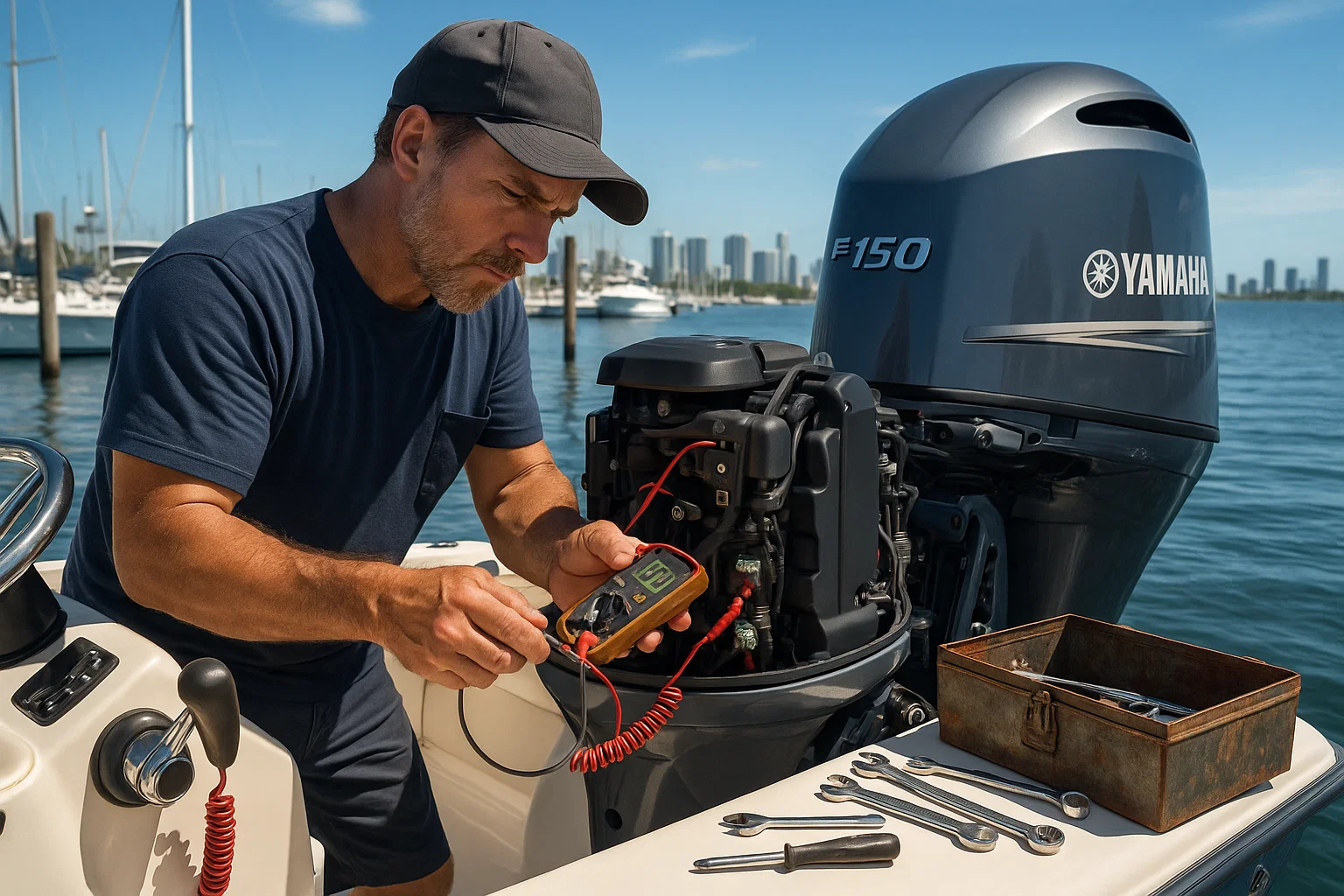Outboard Motor Starter Troubleshooting: 15 Years of Fixes and Hard-Won Lessons
I’ve been fixing outboard motors in South Florida for 15 years, mostly around Miami and Fort Lauderdale, where the saltwater and humidity make every job a challenge. Last July, a guy named Carlos rolled into Dinner Key Marina with his 2023 Yamaha F150, cursing because it wouldn’t start—just a dead click when he turned the key. I’ve heard that sound a hundred times, and it’s rarely the end of the world. This guide walks you through my process for troubleshooting and fixing a silent outboard starter, from quick checks to full replacement. It’s not guesswork—it’s a systematic approach to get you back on the water without wasting $500 on a tow.
Table of Contents
Why Won’t My Outboard Motor Start? The Basics to Check First
Before you even touch a wrench, rule out the simple stuff. I’ve seen plenty of boaters—myself included—waste hours on a “dead” motor that was just a loose kill switch or a blown fuse. These checks take two minutes and can save you a trip to the shop.
Last summer, a client at Key Biscayne had his Mercury 200 silent as a tomb. Turned out, his kid had yanked the kill switch lanyard half-off while playing on the boat. I popped it back in, and the engine fired right up—no charge. Here’s what to check first:
- Kill Switch: That red coiled lanyard isn’t just for safety—it’s a circuit breaker. If the clip’s not firmly seated on the console or tiller, the ignition’s dead. I always tug it to make sure it’s snug.
- Neutral Safety Switch: Your outboard won’t start in gear, period. I’ve seen shifters look neutral but be slightly off, blocking power. Double-check it’s dead-center neutral.
- Main Fuse: Look for a red rubber holder near the powerhead, usually hiding a 20-amp fuse. Pop it open—if the metal strip’s broken or charred, it’s blown. Swap it with the right amperage fuse (check your manual) to avoid frying the system.
These are the low-hanging fruit. Nine times out of ten, one of these fixes the problem, and you’re back fishing by noon.
How Do Bad Battery Connections Stop My Starter?
If the basics check out, the next culprit’s usually the battery or its connections. Salt air in Miami eats terminals like nobody’s business—corrosion’s a silent killer. I had a guy at Stiltsville last June with a 2021 Sea Ray 230, swearing his battery was fine. One look showed green crust on the terminals, blocking power. A quick scrub, and he was good to go.
Here’s my process:
- Inspect the Terminals: Look for white or green corrosion on the battery posts. If you see it, disconnect the negative (black) terminal first—safety first, always. Clean with a wire brush and a baking soda/water mix until it’s shiny.
- Check the Cables: Trace the heavy-gauge cables from battery to engine. Cracks, bulges, or frayed wires mean trouble. I found a split cable on a Boston Whaler last month—$50 fix saved a $300 tow.
- Apply Dielectric Grease: After tightening connections, I dab on grease to keep corrosion at bay. Costs $5 and saves headaches.
Clean connections are non-negotiable. Skip this, and you’re asking for a no-start.
How Can a Multimeter Pinpoint the Problem?
When the basics don’t fix it, it’s time to play electrical detective. A multimeter’s my go-to tool—cheap, simple, and tells you exactly where power’s failing. I keep a Fluke 117 in my truck; caught a bad solenoid on a client’s Bayliner 285 last August, saved him $200 in guesswork.
Testing the Battery
Set your multimeter to DC Voltage (VDC). Touch the red probe to the positive terminal, black to negative. A healthy battery reads 12.6 volts or more at rest. Then, have a buddy turn the key to “start” while you watch:
- Below 9.5–10 volts under load? The battery’s weak—charge or replace it.
- Solid 12.6 volts but no crank? Power’s not getting through. Move to the solenoid.
Checking the Starter Solenoid
The solenoid’s a relay that sends battery power to the starter. Find the small activation wire on it—usually a thin red or yellow one. With the black probe on a good ground (engine block works), touch the red probe to the activation wire. When your buddy hits “start,” you should see 12 volts. Then, check the large output terminal to the starter:
- 12V on the activation wire, no voltage on the output? The solenoid’s toast. I replaced one for $80 on a Yamaha F115 last spring.
- No 12V on the activation wire? Check the ignition switch or wiring upstream.
Verifying Starter Motor Power
If the solenoid’s good, test the starter itself. Put the red probe on the starter’s large power terminal, black on the engine block. Turn the key:
- 12V but no spin? The starter’s internal—brushes or motor failure. Time to replace it.
- Low voltage? Re-check cables or connections for corrosion or breaks.
This method’s saved me countless hours. No guesswork—just follow the power.

What Do Starter Failure Sounds Tell Me?
If the electrics check out but the engine won’t crank, the starter itself is likely the issue. Your ears are your best tool here. I learned this from an old mechanic named Ray in Fort Lauderdale—every sound’s a clue.
- Single, Loud Click: Means the solenoid’s engaging, but the starter’s seized or its brushes are shot. I heard this on a Mercury 150 at Bahia Mar last month—$250 replacement fixed it.
- High-Pitched Whirring/Grinding: The starter’s spinning, but the Bendix gear’s not catching the flywheel. Could be a worn Bendix or damaged flywheel teeth. Cost a guy $300 to fix his Suzuki DF200 last summer.
- Rapid Clicking: Usually a weak battery or bad connection. I saw this on a Grady-White at Coconut Grove—cleaned the terminals, problem solved.
As a last resort, I’ll try the hammer tap trick. Lightly tap the starter casing with a mallet to nudge stuck brushes. It worked once on a client’s old Evinrude, but it’s a one-time fix—replace the starter pronto.

Should I Repair or Replace the Starter?
Once you’ve confirmed the starter’s the problem, you’ve got a choice: fix it or swap it. For vintage outboards, like a 1980s Johnson I worked on in 2018, rebuilding makes sense if parts are available. Brush kits or solenoids run $20–$50, but labor can take hours.
For modern outboards—say, post-2000—a new or remanufactured starter’s usually the better call. I replaced a Yamaha F150 starter for $250 last July; rebuilding would’ve cost $200 in parts and labor with no warranty. New units are reliable, often come with a one-year guarantee, and save you time. Check your manual for part numbers—OEM or trusted aftermarket like Sierra work fine.
How Do I Replace an Outboard Starter?
Replacing a starter’s straightforward if you’re careful. I did one on a Sea Ray’s Mercury 200 at Key Biscayne last June—took 45 minutes. Here’s my process.
Prep and Safety
Safety’s non-negotiable. Disconnect the negative battery terminal first—sparks near the engine block are bad news. Grab a socket set, wrenches, wire brush, and dielectric grease. Before touching wires, snap a photo of the wiring. I learned this the hard way in 2012 when I mixed up cables on a client’s boat—30 minutes of cursing later, I swore I’d never skip the photo again.
Removing the Old Starter
- Disconnect Wires: Undo the nuts on the solenoid and starter terminals. Label them if your photo’s not clear.
- Unbolt the Starter: Find the 2–3 mounting bolts (check your manual). A socket extension helps in tight spots.
- Pull It Out: Wiggle the starter free. It’s heavy—don’t drop it on your foot.
Installing the New Starter
- Clean the Mount: Scrape grime off the engine block with a wire brush for a solid ground.
- Bolt It In: Seat the new starter, hand-tighten bolts, then torque them down (check manual for specs—usually 20–30 Nm).
- Reconnect Wires: Follow your photo. Tighten nuts and add dielectric grease to prevent corrosion.
- Test It: Reconnect the battery (positive first), put the engine in neutral, and turn the key. Should fire right up.
I always double-check connections. A loose wire cost a buddy $200 in diagnostics last year—he swore it was “fine.”
FAQ: Common Outboard Starter Questions
Why Does My Outboard Click but Not Start?
A single click usually means the solenoid’s engaging, but the starter’s seized or brushes are worn. Test with a multimeter—12V at the starter with no action points to a bad motor. I fixed this on a Yamaha F115 for $250 last month. Try a local shop with ABYC-certified techs.
How Often Should I Check My Battery Connections?
Every 6 months in South Florida’s salty air. Corrosion builds fast—clean terminals with a wire brush and baking soda paste. I caught a bad connection on a Sea Ray 230 last June, saved a $300 tow.
Can I Fix a Starter Myself?
Simple jobs like cleaning terminals or swapping fuses are DIY-friendly. Starter rebuilds? Leave it to pros unless you’ve got a vintage motor. I tried rebuilding a Mercury starter in 2015—took 3 hours and failed in a month. Replacement’s faster.
What’s the Cost of a New Starter?
New starters run $150–$400, depending on the motor (e.g., $250 for a Yamaha F150). Remanufactured ones are $100–$300 with warranties. Check Sierra or OEM parts online—saved a client $50 last year.
How Do I Know If My Battery’s Dead?
Use a multimeter. Should read 12.6 volts at rest, not drop below 9.5 volts under load. I caught a weak battery on a Grady-White last summer—$120 replacement fixed it.
Why Does My Starter Whir but Not Crank?
That’s the Bendix gear failing to engage the flywheel. Could be worn teeth or a bad clutch. I fixed one on a Suzuki DF200 for $300 last July. Inspect the gear post-removal.
How Long Does Starter Replacement Take?
About 45–60 minutes with basic tools. I did one at Dinner Key in June—socket set, photo for wiring, done. Double-check torque specs in your manual.
Comparison Table: Common No-Start Issues
I put this table together from jobs I’ve seen in South Florida:
| Symptom | What to Check First | Likely Cause | Next Step |
|---|---|---|---|
| No Sound, No Click | Battery Voltage, Fuse | Dead Battery, Blown Fuse | Charge/Replace Battery or Fuse |
| Single, Loud Click | Solenoid Voltage | Seized Starter or Worn Brushes | Test Solenoid, Replace Starter |
| Rapid Clicking | Battery Under Load | Weak Battery, Bad Connection | Clean Terminals, Load Test |
| Whirring/Grinding | Bendix Gear, Flywheel | Failed Bendix, Damaged Flywheel | Inspect/Replace Bendix or Starter |
What’s the Best Way to Avoid Starter Problems?
Preventive maintenance’s key. I check my Boston Whaler’s battery every 6 months, swap fuses yearly, and keep a multimeter handy. Last year, this caught a failing battery before it stranded me off Stiltsville. Budget $100–$200 annually for checks—beats a $500 tow. Sometimes, though, even the best maintenance can’t stop a worn-out starter. That’s when you replace it and move on.

Author Bio
I’m Alex, a marine mechanic with 15 years of experience fixing outboards in Miami and Fort Lauderdale. I’m ABYC-certified (A6 electrical, A8 engine) and have serviced over 300 motors, from Yamahas to Mercurys. I learned the trade from my dad in our Fort Lauderdale garage and now help boaters avoid costly repairs.


Leave a Reply